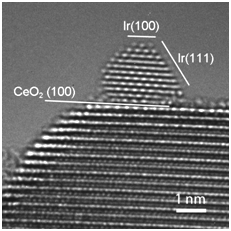STRUCTURE-REACTIVITY RELATIONSHIPS IN NOBLE METAL/REDUCIBLE OXIDE CATALYSTS
WG 3 members: Laurent Piccolo, Thanh-Son Nguyen, Georgeta Postole, Franck Morfin
homepage: www.ircelyon.univ-lyon1.fr
The group activity aims at understanding and controlling the atomic-scale structure of oxide-supported metal nanoparticles for heterogeneous catalysis. In addition to catalytic testing, we use in situ techniques like aberration-corrected ETEM, operando IR and Raman spectroscopies, and surface-science methods to characterize the influence of catalytic environments on the metal-oxide, gas-metal and gas-oxide interface structure. Our current interest in relation to the COST Action CM1104 focuses on two types of systems:

Aberration-corrected TEM image of an iridium nanoparticle epitaxied on a ceria nanocrystal. The Ir-CeO2 catalyst was prepared by solution combustion synthesis and tested in the steam reforming of methane at 750 °C prior to imaging.
- Pt-group metal-ceria nanopowders for CO oxidation, PROX, and methane reforming. The catalysts are prepared by solution combustion synthesis. This one‐pot technique allows one to maximize metal‐oxide interaction and so generate highly dispersed and stable catalysts (see figure).
- Au-based nanoalloys (Au-Pd, Au-Rh…) supported on rutile titania nanorods for the selective hydrogenation of aromatics. Au addition to hydrogenation metals is intended to improve their selectivity and resistance to poisons. Moreover, these materials are suitable for photocatalytic applications.


